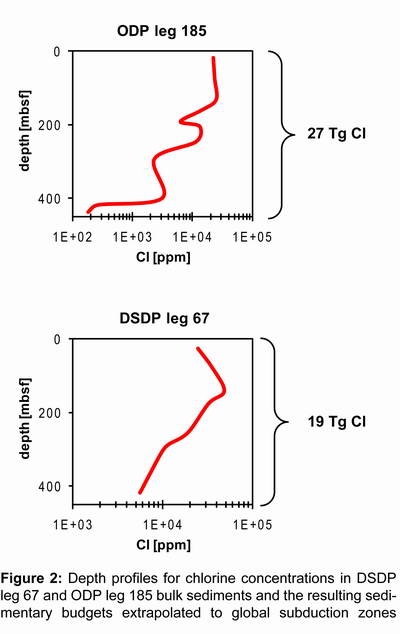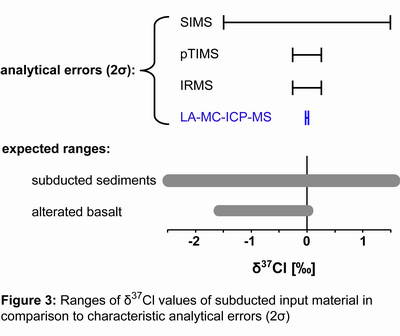 Web Content Display Web Content Display
Volatile input to subduction zonesVolatile turnover in subduction zones and its potential climate feedback is a primary focus of the SFB 574. In order to understand the volatile budgets at subduction zones, we are investigating incoming plate sediments by a combination of geochemical tracers, with a special emphasis on halogen (F, Cl, Br, I) chemistry and stable chlorine isotopes (37Cl, 35Cl). Halogens are cycled through the subduction zone system, usually transported in an aqueous fluid phase, or incorporated into nominally hydrous minerals. They are released through sediment compaction and dewatering in the forearc, but to an important extent transported into the zones of mineral dehydration at mantle depth. There they are likely involved in the generation of subduction zone magmas, from which they may be released into the atmosphere and hydrosphere. Chlorine and bromine are climatically active, and thus important for climate evolution on Earth. The behavior of halogens within subduction zones is only poorly understood, because little is known about halogen contents in solid phases of the input materials (sediments, oceanic plate). Hence hitherto calculations of halogen turnover in subduction zones are based on sparse data sets, resulting in vast uncertainties. To close this gap, we focus our investigations on solid materials. For the quantitative extraction of all halogens out of solid phases without any modification of the stable chlorine isotopic composition, we are using a recently developed low blank pyrohydrolysis device (Fig. 1).
As shown for chlorine concentrations in bulk sediments from the incoming plate off Guatemala (DSDP leg 67) and off Japan/Izu-Bonin-Arc (ODP leg 185), the concentrations of all halogens are highly depth-dependent (Fig. 2). Using chemical compositions and documented physical properties of the sediments, local halogen budgets can be calculated and furthermore extrapolated to the global subduction zone system. The latter would result in 19-27 Tg (1 Tg = 1012 g) sedimentary inventory of global subducting chlorine. For a deeper understanding of the recycling processes in subduction zones and to consolidate resulting mass budget calculations we extend our investigations to several characteristic subduction settings worldwide.
Stable chlorine isotopes are considered as important tracers of geochemical processes, especially in subduction zone systems. Because of only minor fractionation in most natural systems, traditional methods for δ37Cl determination often are to imprecise and have error bars up to the expected δ37Cl variations in the relevant samples (Fig. 3). We developed an alternative and more exact method for δ37Cl determination via LA-MC-ICP-MS (Fietzke et al., 2008), that makes it possible to distinguish such minor differences.
Our ongoing works with incoming plate sediments will be broadened by the investigation of continental “end-members” recently collected in Central Chile.
References and further reading
Barnes JD, Sharp ZD, Fischer TP (2008) Chlorine isotope variations across the Izu-Bonin-Mariana arc. Geol., 36(11), 883-886.
Bonifacie M, Jendrzejewski N, Agrinier P, Humler E, Coleman M, Javoy M (2008) The chlorine isotope composition of Earth's mantle. Science, 319(5869), 1518-1520.
Fietzke J, Frische M, Hansteen TH, Eisenhauer A (2008) A simplified procedure for the determination of stable chlorine isotope ratios (δ37Cl) using LA-MC-ICP-MS. J. Anal. At. Spectrom., 23, 769-772.
|
 Events Events
Kieler Wissenschaftler fühlen den 'Puls der Erde' Wie funktioniert die Recyclingmaschine der Erde?Nach elf Jahren endet der Kieler Sonderforschungsbereich 574 zu Subduktionszonen Final colloquium of SFB 574 Teilprojekt ÖffentlichkeitsarbeitMEERESFORSCHUNG FÜR MICH UND DICH |
|
©SFB574 // Wischhofstrasse 1-3 // D-24148 Kiel // T. +49 (0)431 600 1413 // elange [AT] geomar.de








